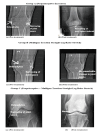Therapeutic Utility of Mulligan Traction Straight Leg Raise Stretch and Proprioceptive Exercises in Osteoarthritis Treatment
- PMID: 39723306
- PMCID: PMC11669387
- DOI: 10.7759/cureus.74382
Therapeutic Utility of Mulligan Traction Straight Leg Raise Stretch and Proprioceptive Exercises in Osteoarthritis Treatment
Abstract
Background Given the increasing incidence and severity of knee osteoarthritis (OA), it is crucial to investigate and refine therapeutic approaches. Aim The objective of this study is to evaluate the effectiveness and potential synergistic effects of proprioceptive exercises combined with Mulligan traction straight leg raise (MT-SLR) in treating OA. This includes improving symptoms such as functional mobility, pain reduction, and relevant serological markers, highlighting the potential of this approach to enhance overall patient outcomes. Methods A pragmatic, community-based, parallel-group, double-blinded, randomized clinical trial was conducted from August 2023 to March 2024. A probability convenience sampling technique was used to calculate the sample size. A total of 130 pre-diagnosed OA patients were randomly assigned to three groups via the lottery method. Group A received proprioceptive exercises, group B received the MT-SLR, and group C received both proprioceptive exercises and MT-SLR. The Pain Catastrophizing Scale (PCS), Numerical Pain Rating Scale, Western Ontario and McMaster University Osteoarthritis Index (WOMAC), erythrocyte sedimentation rate (ESR), flexion, CRP, bone electrolytes in blood (calcium, magnesium, and phosphorus), and X-rays were used to quantify pain, stiffness, functional activities, biochemical parameters, and radiographic findings at baseline and after the 24th session. Data were analyzed using IBM SPSS Statistics for Windows, Version 23.0 (Released 2015; IBM Corp., Armonk, NY, USA), with a p-value of <0.05 considered statistically significant. Results Out of the 130 participants, 126 were analyzed at the 24th session, comprising 50 males and 76 females. After 24 sessions, Group C (combined therapy) exhibited the most significant improvements across all parameters (p = 0.000), including flexion range of motion, WOMAC Pain, activities of daily living, stiffness, and PCS, outperforming both Group A (p = 0.011) and Group B (p = 0.005). Group C also demonstrated the greatest reductions in ESR (p < 0.001), CRP (p < 0.001), and IL-6 (p < 0.001), along with the highest improvements in calcium, magnesium, and phosphorus levels (p < 0.005). X-ray assessments revealed that Group C had the most notable joint space recovery, while Group B showed no changes. Conclusions In the treatment of knee OA, proprioceptive exercises have been found to be more effective than the MT-SLR stretch. Given the rising prevalence and severity of knee OA, this study emphasizes the need to explore and refine treatment strategies. The findings indicate that combining MT-SLR with proprioceptive exercises yields superior results compared to either intervention alone. The group receiving the combined therapy showed the most significant improvements across several key measures, including functional mobility, pain reduction, and relevant serological markers, highlighting the potential of this approach to enhance overall patient outcomes. The notable differences in performance between the treatment groups suggest that a more comprehensive, integrative approach to knee OA could lead to better management outcomes.
Keywords: functional activities; mulligan traction; osteoarthritis; physical therapy; proprioceptive exercises.
Copyright © 2024, Iqbal et al.
Conflict of interest statement
Human subjects: Consent for treatment and open access publication was obtained or waived by all participants in this study. Institutional Ethics Committee, Muhammad Institute of Medical and Allied Sciences issued approval MIMAS/06/26/Maliha. The trial was approved and registered with the Registry of Clinical Trials (IRCT20230202057310N2). Ethical approval has also been obtained. Animal subjects: All authors have confirmed that this study did not involve animal subjects or tissue. Conflicts of interest: In compliance with the ICMJE uniform disclosure form, all authors declare the following: Payment/services info: All authors have declared that no financial support was received from any organization for the submitted work. Financial relationships: All authors have declared that they have no financial relationships at present or within the previous three years with any organizations that might have an interest in the submitted work. Other relationships: This is the final year research project of the first author.
Figures


Similar articles
-
Comparative analysis of piroxicam and post-isometric exercises in knee osteoarthritis in school teachers.Work. 2025 May;81(1):2425-2432. doi: 10.1177/10519815241305001. Epub 2025 Jan 7. Work. 2025. PMID: 39973644 Clinical Trial.
-
Impact of Proprioceptive Exercises on Pain, Balance, and Fall Risk in the Elderly With Knee Osteoarthritis: A Randomized Clinical Trial.Cureus. 2024 Oct 5;16(10):e70885. doi: 10.7759/cureus.70885. eCollection 2024 Oct. Cureus. 2024. PMID: 39497862 Free PMC article.
-
Synergistic effect of Majoon-e-Suranjaan and isometric exercises in improving rheumatoid arthritis.Am J Transl Res. 2025 Feb 15;17(2):1018-1028. doi: 10.62347/ZRFI2658. eCollection 2025. Am J Transl Res. 2025. PMID: 40092121 Free PMC article.
-
Proprioceptive Training and Outcomes of Patients With Knee Osteoarthritis: A Meta-Analysis of Randomized Controlled Trials.J Athl Train. 2019 Apr;54(4):418-428. doi: 10.4085/1062-6050-329-17. Epub 2019 Apr 17. J Athl Train. 2019. PMID: 30995119 Free PMC article. Review.
-
Quantitative analysis of effectiveness and associated factors of exercise on symptoms in osteoarthritis: a pharmacodynamic model-based meta-analysis.Br J Sports Med. 2024 Dec 18;58(24):1539-1550. doi: 10.1136/bjsports-2023-107625. Br J Sports Med. 2024. PMID: 39393837
References
-
- Fundamentals of osteoarthritis: inflammatory mediators in osteoarthritis. De Roover A, Escribano-Núñez A, Monteagudo S, Lories R. Osteoarthritis Cartilage. 2023;31:1303–1311. - PubMed
LinkOut - more resources
Full Text Sources
Research Materials
Miscellaneous
